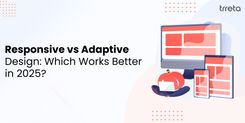Did you know that many digital products fail not because of technical limitations or budget issues, but because they forget the most important element - the people who will actually use them.
The good news is - this challenge can be solved by human-centered design.
Instead of starting with features or technology, human-centered design, often called HCD, begins with understanding real people, their goals, pain points, and contexts.
In simple terms, it’s an approach to product design that keeps users at the heart of every decision, creating solutions that are not only functional but also meaningful.
In this guide, we’ll explore what is human-centered design, its core principles, a step-by-step process to apply it, practical examples, and why HCD is essential for businesses aiming to build products that truly resonate.
What Is Human Centered Design?
So, what is human centered design exactly?
In the simplest terms, it’s an approach to creating products, services, and experiences by deeply understanding and prioritizing the needs, motivations, and limitations of real users.
Where traditional design might start with business requirements or tech constraints, human centered design takes a different approach.
It starts with empathy combined with observation, interviewes, and learning from people to define problems before creating solutions.
So in short, human centered design meaning boils down to designing with people, not just for them. That’s what makes it different from old-school design methods that treated users as an afterthought.
Whether you call it human centric design, humanized design, hcd design, or human center design, the philosophy remains the same - build what your users actually need.
So let’s now find out how human centered design is created in the following section.
What’s The Process Behind Human Centered Design

The human centered design process is more of a learning cycle that includes consistent process of creating, and refining.
Whether you are working with AI/ML development company to create the most amazng app or a platform or you are designing a product that people can interact with physically - here are the step-by-step look at how successful teams put it into practice:
1. Research
The first step includes talking directly with potential users. Run interviews, conduct field studies, send out surveys and get qualitative and quantitative insights.
2. Define
Once the research is done, it’s time to summarize what you’ve learned into user personas, pain points, and journey maps. This creates a shared understanding of who you’re designing for.
3. Ideate
Moving next, it’s time to have brainstorming sessions to explore creative ways of solving users’ problems. Sketch ideas, challenge assumptions, and think broadly.
4. Prototype
Once the idea is almost ready, the next stage includes building low-fidelity mockups or interactive models of your solution. Prototypes let you test concepts before spending time and money on full development.
5. Test & Iterate
When the prototyping is done, you need to put your prototypes in front of real users to gather feedback, spot usability issues, and improve your design in cycles.
All of these five steps are quite an important components of human centered design process which shapes the bigger sphere of human centered design methodologies used by leading UX teams worldwide.
Why Human Centered Design Process (HCD Principles) Matters So Much Today?

Today businesses can’t afford to have products that leave users confused or frustrated as it cost millions of dollars and years of trail and error.
However, the good news is when you build with a human focused design approach, you don’t just create apps or websites, you build experiences that connect.
Here’s why human design process matters:
- Better Conversions & Retention: When your products are tailored to users’ needs drive higher adoption and reduce churn.
- Stronger Word-of-Mouth: Not only higher retention rate, but when your users are happy with human first expereinces, they become advocates who bring in more users for your app/products organically.
- Brand Loyalty: A product that feels intuitive and empathetic encourages long-term customer relationships - increasing lifetime value and brand loyalty of the customer.
- Reduced Rework: Last but not least, when your products are aligned with the real needs of the users, it helps you save time and money that you would need to spend later in revisions.
When you prioritize human centered design process, you set your business apart from competitors who focus solely on technology or aesthetics.
Need help applying these principles? Trreta’s UI/UX team specializes in human centric design strategies that bring your product ideas to life.
What are the Key Principles of Human Centered Design in UI/UX?

The best human centered designers don’t just check boxes, they follow key mindsets.
Here are the most important hcd principles for creating exceptional digital products:
- Empathy with Real Users
Rule number one is to go beyond assumptions. Observe, interview, and truly understand the people you’re designing for.
- Co-Creation and Iterative Design
Secondly, you need to design with users. Invite feedback throughout your process (while you are ideating, prototyping and testing), not just at the end.
- Inclusive and Accessible Solutions
Moreover, consider users with different abilities, languages, and contexts to ensure everyone can use your product.
- Prototyping and Testing with Feedback Loops
The thumb rule is to build small, test fast, and learn continuously as early feedback prevents expensive mistakes.
- Balance Between User Needs and Business Goals
Finally, align design with what users need and what the business must achieve as both of them equally matter.
So next time when someone asks you, what are the key principles of human centered design in UI/UX? you now know the answer!
What Are The Human-Centered Design Techniques & Tools?

Knowing what to do is one thing, and knowing how to do it is another; and the same rule applies when it comes to human centered design techniques and tools.
Here are proven human centered design techniques that put HCD into action:
- User Story Mapping: Visualize the steps users take, revealing gaps and opportunities.
- Wireframing & Prototyping: Create drafts of pages and flows before finalizing visuals or code.
- Usability Testing: Observe how real users interact with prototypes, identifying friction points.
- Accessibility Audits: Check products for color contrast, keyboard navigation, and screen reader compatibility.
- Service Blueprints: Map internal processes behind user experiences, helping teams see the big picture.
When you focus on these human focused design tools, they don’t just improve UX but they also help you align teams around user needs.
What Are Some Real-World Human Centered Design Examples?
After knowing quite a few concepts about human centered designs, it’s no wonder that you are curious to find out some real-life examples of it.
Here are two human centered design examples that will help you understand the concept even better -
- Airbnb’s Design-Led Turnaround

One of the most famous examples of human centered design is Airbnb. When the company was struggling to gain traction, the founders decided to apply HCD principles to better understand the needs of their users.
And to do so, they traveled to New York to meet with hosts and guests, gaining insights into their experiences and challenges.
They discovered that poor-quality photos of listings were a significant pain point for users. So they rented a camera, took high-quality photos of the listings themselves, and saw an immediate increase in bookings.
This small but impactful change was the result of deep empathy, a clear definition of the problem, and a willingness to iterate based on user feedback.
As a result, today, Airbnb is a global success, largely due to its commitment to understanding and addressing the needs of its users.
By applying human centered design methodologies, the company was able to turn a struggling startup into a multibillion-dollar business.
- Apple’s Customer-First UX

Another great example of human centered design can be seen in Apple’s products.
Though the company has been innovating a lot, in one of their iteration, they removed the home screen button from the center.
Now this approach of taking away the home button didn’t just alter the appearance of the iPhone, but it improved its capabilities as well.
The removal of button, the company was able to free up the space that was taken by the cables which also removed the possibility of the phone breaking. And as it’s unlikely the user would need to touch the top of the screen, so this ensures protection even further.
From the iPod scroll wheel to the intuitive iPhone interface, today, Apple’s products are leading because they obsess over every user interaction.
So, what can you learn, as a business, from these two examples?
Empathy-driven design can save you from failure and help you lead the market with innovation.
What Are The Benefits of Investing in Human Centered Design Methodologies?

There’s a reason top brands practice and follow human centered design methodologies in all of their products.
Here are some of them -
- Reduced Rework & Cost: Aligning products with user needs early prevents expensive fixes post-launch.
- Faster Adoption: Solutions that feel intuitive encourage users to adopt them quickly.
- Better Accessibility: Inclusive design expands your potential customer base.
- Differentiation: In crowded markets, user-centered products stand out and earn loyalty.
Let Your Product Follow The Best Human Centered Design Process with Trreta
There’s no doubt that today human-centered design isn’t just a random word but a mindset that can make the difference between a product that struggles and one that thrives.
By investing in human centered design, you’re not only creating more usable products; you’re building trust, loyalty, and competitive advantage.
If you’re serious about making your digital products resonate, it’s highly recommended to find the right UI/UX design company that can understand your vision and work accordingly.
At Trreta, we bring years of expertise applying human centric design to everything from enterprise dashboards to consumer apps.
So if you are ready to build something that’s amazingly human-centric, contact us today to learn how Trreta can help you design products your customers will love.
FAQs
Q1. What is the core idea behind human-centered design?
The idea of HCD is simple - placing real users at the center of every design decision to solve their actual problems.
Q2. How does human-centered design improve business outcomes?
HCD principles helps you increase conversions, reduces churn, and boosts word-of-mouth by delivering intuitive, valuable experiences.
Q3. What industries benefit most from adopting HCD?
Human centerd designs can benefit every industry, especially those where digital products touch customers daily, like SaaS, finance, healthcare, and eCommerce.
Q4. What’s the difference between UX design and human-centered design?
While UX focuses on the user experience; HCD is a broader mindset prioritizing users from ideation through delivery.
Q5. Can startups implement HCD without big budgets?
Yes, as a startup you should invest in HCD with the best budget you can start with to make sure you outperform your competitors and win the hearts of your customers.





